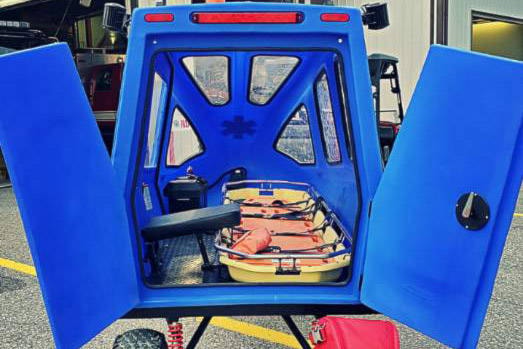Sundre Fire Department’s response area covers 3,800 kilometres and they now have a mini ambulance to make it easier to treat and transport patients out of remote areas.
The “snowbulance” is a lightweight enclosed trailer that can be pulled by an ATV into remote areas where larger rescue vehicles cannot go. Equipped with a heater, interior lights and suspension, the snowbulance provides a comfortable place for patients while they are transported out of the bush to waiting air or ground ambulances.
“It’ll accommodate the patient, a medic and all of the medical kits and things like that,” said Sundre Fire Chief Ross Clews.
In the winter, the low-pressure tires can be taken off and replaced with skis.
The trailer has already shown its value, said Clews.
On the August long weekend, a horseback rider was injured in a remote part of the Ya Ha Tinda, a huge natural area west of Sundre. They were loaded into the snowbulance to make the journey out.
“They guys were telling me it’s very stable, even when loaded with the patients and everything else,” he said. “It works very well.”
The injured horse rider also gave the snowbulance good reviews.
Deputy Fire Chief Dave Bennett said he first saw the snowbulance at a fire chiefs gathering in Red Deer about five years ago. Seeing the potential of the vehicle, he did more research and tracked down the manufacturer, Winnipeg-based Equinox Industries Ltd.
The $10,000 snowbulance is a significant step up from the open trailer the fire department had used previously, said Bennett.
“In my past experience with our typical ATV steel trailer it was just too heavy and too rough of a ride for the patients. It was just a constant struggle,” he said. “This trailer probably weighs a third what our other one did.”
A big advantage with the snowbulance is it is fully enclosed and patients can be loaded through double doors at the back.
“Your patient is out of the elements. That was my biggest thing,” he said. Previously, they had to rely on tarps and blankets to keep patients warm and protect them from rain or snow.
“If you have a delay on STARS or it’s a few miles out to the ambulance at least they’re warm and somewhat comfortable.”
Snowbulances have been used elsewhere in Canada, either by rescue groups or at ski hills, but they appear to be relatively new to Alberta based on his research.
